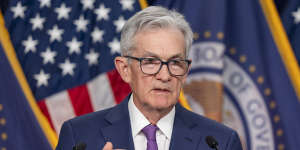Overnight,bitcoin briefly topped $US69,000 ($106,000) before tumbling back to around $US64,000. At its peak,the cryptocurrency had soared nearly 80 per cent in the past year and more than 300 per cent from its recent nadir in November 2022.

The slump in the value of crypto assets roughly coincided with the start of the Fed’s rate-hiking cycle in March 2022.Bloomberg
There are some crypto-specific factors in the resurgence of the flagship for crypto assets,the most significant of which has been the US Securities and Exchange Commission’s begrudging decision to approve the spot trading of bitcoins by exchange-traded funds (ETFs).
That approval came after a court ruling last August that the commission had improperly denied an application from an asset manager to create a bitcoin ETF.
It was that judgement that rekindled the market for bitcoin and which has seen the market capitalisation of crypto assets double,from about $US1.2 trillion before the ruling to around $US2.4 trillion this week.
The ETFs have attracted about $US15 billion of inflows in two months,with major asset managers like BlackRock involved. That’s given bitcoin a tinge of mainstream credibility it previously didn’t have,and one which looked impossible when,after peaking at almost $US3 trillion in 2022, amid a wave of collapses and scandals. Bitcoin was trading below $US16,000 in late November of that year.
The other crypto-related influence over recent bitcoin prices has been the imminent “halving” of the number of coins that can be “mined,” an event that occurs every four years and which restricts the volume of new coins available to the market.
With new sources of demand created by the ETFs,which make it simpler and less risky for investors to trade bitcoins than the complex,cumbersome and demonstrably risky system of digital wallets and intermediaries with questionable credentials,the halving will tighten supply.
The introduction of the ETFs and the halving,which will occur next month,are,however,the micro influences on bitcoin’s price. The more powerful macro influence is the direction of US interest rates.
It is no coincidence that the tanking of bitcoin’s price,and those of crypto assets more generally,occurred during a period when the Fed was ratcheting up US interest rates,and with its quantitative tightening (allowing bonds and mortgages it acquired during the pandemic to mature without investing the proceeds),tightening US financial conditions.

The slump in the value of crypto assets roughly coincided with the start of the Fed’s rate-hiking cycle in March 2022. Eleven rate rises that took the federal funds rate from effectively zero to 5.5 per cent over about 15 months batter all risk assets,not just crypto assets. The US sharemarket fell more than 20 per cent in the months after the Fed’s first move.
Perhaps because the crypto ecosystem was mired in collapses and controversies through the back half of 2022 –, and the arrests of and among them – crypto prices started moving much later than the sharemarket,which started to rebound from mid-October 2022.
That rebound was turbocharged by the launch of ChatGPT in November of that year,which ignited feverish trading of stocks with artificial intelligence exposures and drove the sharemarket to record levels this year.
The sharemarket’s surge,however,wasn’t just driven by AI or the big tech stocks but by a conviction that the Fed would start cutting interest rates this year,with the bond market at one point early in the year pricing in as many as six 25-basis-point reductions.
That optimism took a hit at the end of January when,after a Fed meeting,it became apparent that,rather than the March cut that some had anticipated,the central bank’s commentary probably ruled out any change in policy until mid-year at the earliest.
Despite that,investors in risk assets remained convinced that rates would start to fall and fall quite materially this year.
Weak economic data for February released over the past few days – data perceived to have strengthened the case for rate cuts – was a major factor in the ebullient performance of bitcoin on Tuesday,which contrasted with the performance of the sharemarket,which fell as the data suggested the prospect of a soft landing for the US economy might be receding.

US Federal Reserve chairman Jerome Powell. Markets are on edge waiting for when the central bank will start cutting rates.AP
Sharemarket investors have been pricing in the perfect outcome of interest rates falling even as the US economy continues to grow solidly. The latest data raises a question mark over whether they can have both.
Bitcoin is,on the spectrum of risk assets,at the riskiest end and,with significant leverage underlying its trading,highly leveraged to changes in the risk environment. On Tuesday,the environment was very much one of “risk on.”
That underscores bitcoin’s role as a vehicle for pure speculation. It has no intrinsic value. It isn’t any sort of medium for exchange (except,perhaps,for illegal activity). It is,however,an asset that provides a way to make leveraged bets on a risk environment that is being driven by expectations of what the Fed may or may not do in the relatively near future.
It is notable that,year-to-date,the NYFANG index,which includes all the big tech companies and has been boosted by the frenzy over AI,is up just under 12 per cent. Bitcoin is up more than 50 per cent. That’s leverage!
While the market for bitcoin has been structurally changed by the introduction of the ETFs,which brings with it a degree of institutionalisation of the market,it is the macro settings and what happens to US interest rates in future that will determine whether its surge continues or whether it falls back into the boom and bust cycles that have characterised its past.
The volatility of trading on Tuesday and early Wednesday – up about 6 per cent and then down nearly 8 per cent against the 2.3 per cent fall in the rate-sensitive big tech stocks – does tend to signal,however,that it will remain among the most volatile and riskiest of risk assets.
Read more:
The Market Recap newsletter is a wrap of the day’s trading..